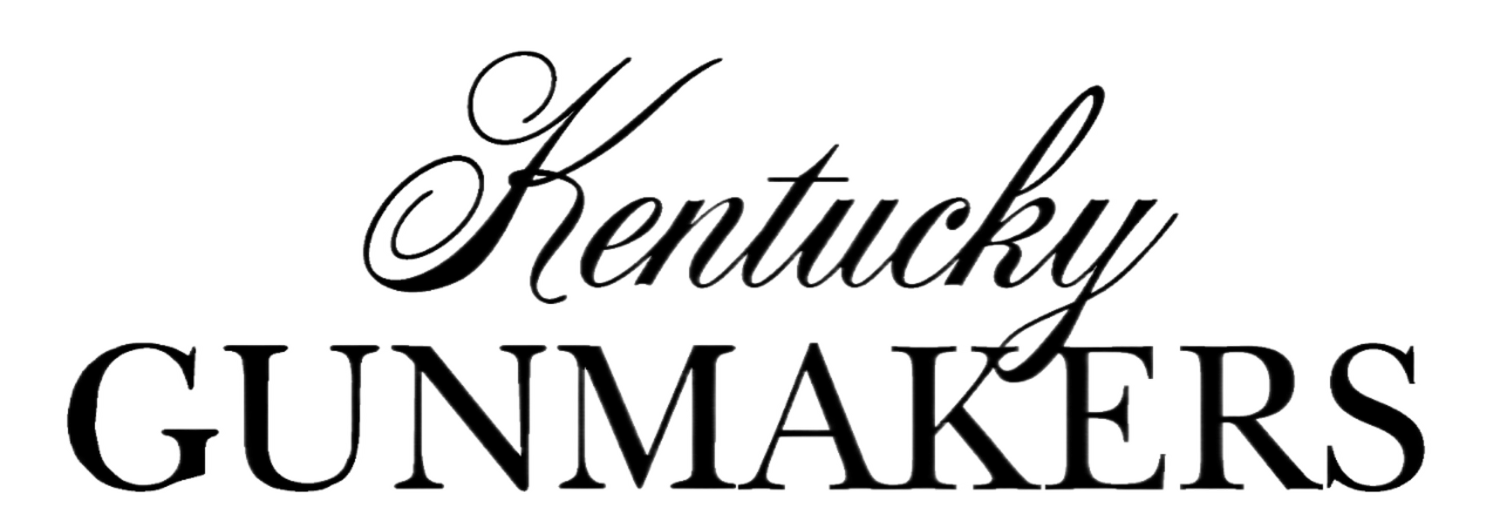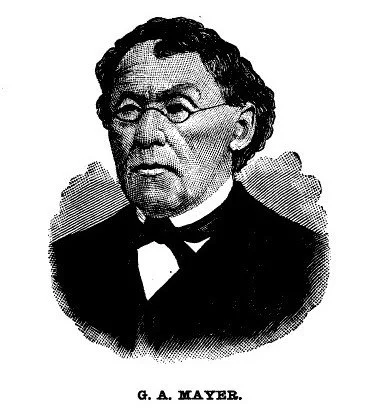A Rare Kentucky Under-Hammer Rifle by Gunsmith George A. Mayer ©
Foreword: Under-hammer pistols from Kentucky are rare with only a handful of Kentucky gunsmiths known to make them, and under-hammer rifles are nonexistent… at least until a signed example recently sold at auction. The gun was stocked in curly maple with its barrel stamped “G. A. Mayer” as seen in Figure No.1. George A. Mayer was a successful gunsmith and businessman at Henderson in Henderson County, Kentucky, located on the Ohio River across from Evansville, Indiana. The author had never seen or heard of a Kentucky-made under-hammer rifle in over forty years of collecting Kentucky firearms. making the discovery a noteworthy event.
Figure No.1: The newly discovered under-hammer rifle is marked “G. A. Mayer” for gunsmith George A. Mayer of Henderson County, Kentucky. The mark is important because the author has never seen another signed example of his work.
George A. Mayer: Mayer was born in Germany in 1799 where he learned gunmaking and married. He moved to America in 1832, arriving in New York and then moving inland to Pittsburgh, Pennsylvania. In 1834 he moved to Evansville in southern Indiana on the Ohio River, where he resumed his gunsmithing work. A year later he moved a short distance across the Ohio River to Henderson in Henderson County, Kentucky, where he became the county’s best-known and most successful gunsmith for many years. Figure No.2 shows Mayer in his later years when a wealthy and well-respected citizen of Henderson. Eventually he added hardware to his gunsmithing business, and in 1880 he turned the business over to his sons Jacob and Virginius Mayer and retired a wealthy man.
Figure No.2: Kentucky gunmaker George A. Mayer was a German immigrant and gunsmith who settled at Henderson in Henderson County, Kentucky, in 1835 and built a prosperous business as a gunsmith and hardware dealer. He was known to be meticulous in his work, honest in his business dealings, and dedicated to giving full satisfaction to his customers. He retired from gunsmithing in 1880 as a wealthy and prominent citizen of Henderson.
The Under-Hammer Rifle: Under-hammer rifles and pistols were a lower cost alternative to percussion lock guns. Most under-hammer rifles were from the New England states, while under-hammer pistols were more widely accepted and made in other states due to their simplicity and lower cost. The mechanism was simple. The hammer had a notch in its base that, when cocked, caught on the end of the trigger’s long front extension. When the trigger was pulled back, it dislodged itself from the notch in the hammer, allowing the hammer to drop and fire the gun. Mayer’s rifle, shown in Figures No.3 and No.4, is built like most under-hammer rifles with a butt stock, barrel, and the simple hammer/trigger mechanism seen in Figure No.5. Under-hammers were thought by some to be safer to shoot, since debris from a rare exploding percussion cap went downward, not toward the shooter’s face. However, in Kentucky where history and tradition ran so deeply, conventional percussion lock rifles were greatly preferred. Daniel Boone and Simon Kenton never used under-hammer guns, so neither did most later Kentuckians! The rifle has erosion around the nipple area from percussion cap residue, but the erosion is light, indicating only moderate usage rather than the heavier usage common to most percussion rifles from Kentucky. The lighter erosion and good nipple condition suggest the under-hammer may have been more a novelty gun than actual working rifle.
Figure No.3: A full-length view of Mayer’s under-hammer rifle shows its triangular butt made from fine curly maple wood. Despite being an under-hammer, the gun retains much of the look of a conventional Kentucky percussion rifle… except for the obvious lack of a trigger guard. Barrel: 35-1/2 inches long with .38 caliber bore and rare 8-groove rifling. Author’s collection, photo by Author.
Figure No.4: The reverse of the under-hammer rifle shows its fine curly maple stock with round cheekpiece, dog inlay, and raised side-facings in the wrist area behind the barrel. Butt architecture is the typical crisp triangular shape found on most Kentucky guns. The butt curvature, remnants of side-facing panels and high, well-shaped cheekpiece suggest the under-hammer rifle dates to the early-to-mid 1840s. Author’s collection, photo by Author.
Figure No.5: The firing mechanism is simple, with a notch in the base of the hammer that catches the trigger extension when cocked. The trigger is pulled out of the notch when fired, dropping the hammer.
Figure No.6: The cheekpiece inlay on the Mayer rifle is well-done in German silver and nicely detailed with several piercings. The dog figure suggests the gun was a sporting and small game rifle.
The rifle was probably a special order gun by a demanding customer who had seen eastern under-hammers, was curious about them, and wanted a similar rifle in Kentucky. Details suggesting a special-order gun, in addition to its under-hammer ignition, include the hunting dog inlay in the raised round cheekpiece seen in Figure No.6, neatly carved faux side facings on either side of the butt just behind the breech, and fancy matching finials on the toe plate [see Figure No.7] and trigger plate. A fine piece of curly maple was used for the butt stock, and the cheekpiece sits proudly above the butt’s surface, both indicative of a superior gun. Dating the under-hammer rifle is subjective since it is the only known Kentucky under-hammer to-date, and no other signed Mayer rifle has been published for comparisons. Based on the gun’s retained side facings, barrel length, well-carved cheekpiece and extended toe, it probably dates to about 1840-1845.
Figure No.7: Both the toe plate and trigger plate have matching lobed finials, as seen here on the toe plate. The gun is not heavily decorated, but its several artistic details and fine construction make it an above-average rifle despite being an under-hammer.
Summary: Kentucky under-hammer pistols by several different makers have been known for years, but under-hammer rifles from Kentucky did not exist… at least not until a well-signed example recently appeared at auction. The gun was signed by gunsmith George A. Mayer of Henderson in Henderson County, Kentucky. Not only was the Mayer gun Kentucky’s first documented under-hammer rifle, but it was also the first signed George Mayer rifle known to the author despite Mayer’s many years of working as a gunsmith in Henderson. The rifle had several details suggesting it was a special-order gun and not a typical example of Mayer’s work. But like most good gunsmiths, Mayer could make just about anything a customer asked for, even if it was a non-standard, Eastern-style under-hammer of limited use in Kentucky.







